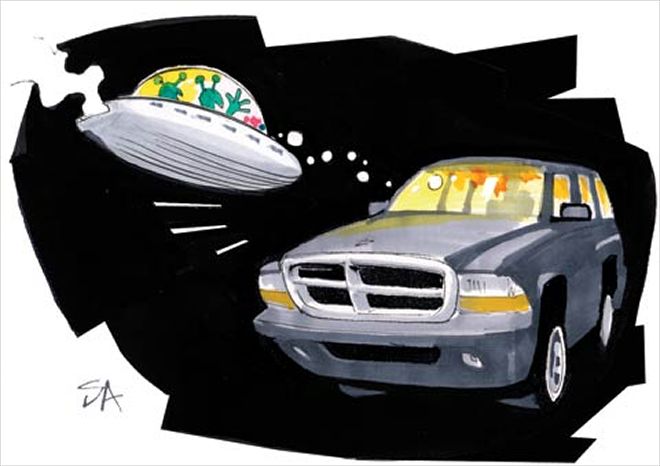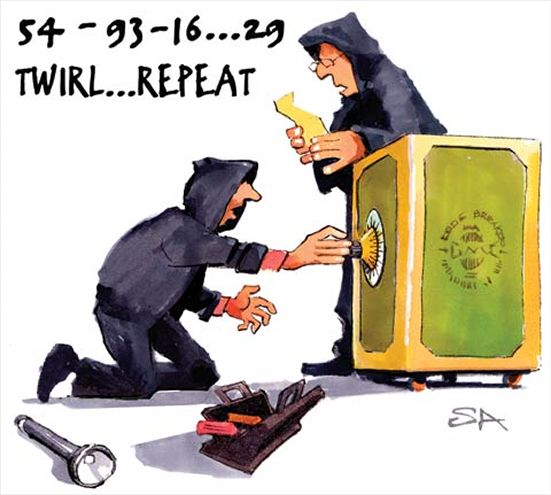Blinking LightsQ: The dome lights in my 2003 Durango flicker on and off when all the doors are closed. Is this a short, a bad ground, or a bad switch?

| 163 0604 Expert Advice 02z
A: Check the doorjamb switches, which are often simple gadgets mounted within the doorjamb. They get pushed in to break a circuit and turn off the interior lights when the doors are closed, and are spring-loaded outward to complete a circuit and turn on the lights when a door is opened. These are a common source of problems due to accumulated wear and tear inflicted every time a door is opened or closed. The 2003 Dodge Durango uses "door-ajar" switches, which are integral parts of the door-latch assemblies, located inside each door. These aren't so easy to test and/or replace and require removal of the interior door panel. Of course, there are several other potential causes of flickering lights. Each door-ajar switch sends a signal to an electronic unit known as the central timer module. This module--after evaluating data including but not limited to a door being open--makes the decision as to which lights go on, when, and for how long. In other words, today's systems are more complex, and your problem may be a switch, an electronic module, a relay, or a poor connection in a number of circuits. A qualified technician with the appropriate wiring diagram should be able to pinpoint the problem fairly quickly. In the meantime, try this: With the doors closed and windows down, hold each door and rock it in and out. If the lights flicker with the motion of one particular door, that door-latch assembly is most likely the cause.
Staying LegalQ: Is it possible to unhook the catalytic converter on a 1998 Dodge Ram Sport pickup without any problems?
A: The Environmental Protection Agency prohibits the removal (or rendering inoperative) of specific emission-control devices, including the catalytic converter. The maximum fine is $2500, but there's more to it than breaking the law. The catalytic converter is an exhaust-system component designed to reduce three harmful emissions: carbon monoxide (CO), hydrocarbons, and nitrogen oxides (NOx). Your particular Dodge Ram, along with the majority of late-model motor vehicles, utilizes two or more oxygen sensors. One is located in the exhaust system between the engine and the catalytic converter, and another is positioned downstream, after the converter. These sensors read the amount of oxygen in the exhaust gases and send the information to the system's computer (powertrain control module). This enables the PCM to determine if the catalytic converter is functioning correctly by evaluating the difference in oxygen content before and after the exhaust is processed though the converter. A failure will light up the "Check Engine" light on the instrument panel, store a trouble code in the computer's memory, and prevent proper operation of the system. Sure sounds like a problem to me.
Engine Turns BlueQ: I've recently noticed blue smoke coming from the tailpipe of my 1989 F-250. It's a 460-cubic-inch engine with over 180,000 miles. It seems to start smoking when the truck is left idling for five to 10 minutes. I've never noticed it while driving. Is it time to trash the engine?

| 163 0604 Expert Advice 03z
A: First, be sure the positive crankcase ventilation system is functioning properly, with a good source of vacuum from the intake manifold. The blue smoke could be from excessive oil consumption. Second, there could be sludge buildup under the valve covers, on top of the cylinder heads, which blocks oil return passages and forces oil past the valve guides and into the combustion chamber. Worn valve seals, guides, and piston rings also are possible causes. Diagnosis includes compression testing and disassembly. I can understand why you wouldn't want to spend a lot of money on an engine with 180,000 miles on the clock. It's possible that once you fix the top end, the bottom end could go soon after. If it's determined to be a significant internal problem, price a rebuilt or remanufactured engine in your area.
Resetting Oil MonitorQ: How do you reset the oil-change light on a 1999 GMC Sierra SLE?

| 163 0604 Expert Advice 04z
A: The 1999 Sierra uses GM's "Engine Oil Life Monitor" system. The PCM analyzes vehicle information to estimate the appropriate time to change the oil--usually 3500 to 7500 miles since your last oil change. It looks at engine speed, coolant temperature, engine load, intake air temperature, and, of course, mileage incurred. However, one important item the engine oil life monitor can't detect is dirt. Be sure to change the oil at least every 3000 miles if driving in dusty areas. To reset the system after changing the oil, turn the ignition on without starting the engine. Press the accelerator pedal all the way to the floor and then release it slowly--do this three times within five seconds. The change-oil message on the instrument panel should flash for five seconds confirming the reset. If it doesn't, and the light remains on after starting the engine, repeat the procedure.
Locked Air DoorsQ: I use my 1997 Ford Ranger as a work truck. The A/C is on the blink, the system is stuck in the defrost mode, and when you turn the knob it doesn't respond. Plus, it only blows air out of the defrost vents. Is there a flap that might be stuck? Maybe a fuse?
A: There's never one easy answer, and possible causes range from a faulty air-conditioning control assembly to a small animal wedged in the ductwork. Your system uses vacuum-powered motors to open and close "air doors." These doors direct airflow to the desired locations--up for defrost, down for heat, and in the middle for air-conditioning. Many HVAC (heating, ventilation, and air-conditioning) systems that use vacuum controls have a common default position in case of a complete loss of vacuum. The default position directs airflow straight up to the defrost vents so you can still see through the windshield. Check some basics yourself before seeking professional help. Open the hood and look for a black plastic ball on the right side of the engine compartment, about six inches wide with two vacuum hoses attached. That's the vacuum reservoir tank, which stores extra vacuum needed by the HVAC system under certain driving conditions. Be sure there are no cracks in the tank and that the hoses leading to the intake manifold and through the firewall are attached and in good condition, not bent or kinked. Also, you can start the engine and remove one line at a time and feel for the presence of vacuum with your finger. Hopefully, you can find a leak or blockage and repair accordingly. If not, get it to a qualified technician.
Uncool Faulty FanQ: The air-conditioner and electric cooling fan stopped working in my 1998 Jeep Cherokee (4.0-liter I-6). The fan for the air-conditioner and heater works, but can't blow cold air. I've checked all related fuses and relays, the refrigerant level, and hooked the cooling fan directly to power. Everything was fine. Is this a control-module problem?
A: It's possible, but there's a lot more to it. The PCM manages air-conditioning compressor and coolant-fan operation, but it has to see the correct incoming signals before sending outgoing commands. When the climate-control head is switched to A/C-on mode, a signal is sent to the PCM. The PCM must also receive a signal from the A/C low- and high-pressure switches before it turns on the compressor and/or coolant fan. These switches prevent damage to the system. I'm not sure what method you used to check for a sufficient charge of R-134a refrigerant, but a low charge will kill the signal from the low-pressure switch and therefore prevent the system from working. It could be a low refrigerant charge, defective PCM, faulty climate-control head, one of the pressure switches on the blink, a break in related power, or an issue with the ground circuit wiring. Or you may have missed a bad fuse or relay. Don't buy any parts until you get an accurate diagnosis of the problem.
Trouble Codes TrippedQ: I own a 2000 Jeep Wrangler with a 4.0-liter I-6. The engine light recently came on, and the diagnostic code is for a throttle-position sensor fault #24. Are those easy to change or should I take it to a Jeep dealer to get it fixed?
A: First, take it to Jeep service and confirm the problem. It may still be covered under the emissions warranty. But I'm not sure where "#24" came from. Three trouble codes regarding the TPS, which are stored within the PCM's memory, are P0121 (TPS signal doesn't correlate with engine vacuum), P0122 (TPS voltage too low), and P0123 (TPS voltage too high). The TPS is located on the throttle-body assembly on top of the intake manifold. Its purpose is to tell the master computer how far your foot is into the gas pedal. It's mounted with two screws and needs to be carefully fitted over the end of the throttle shaft. It's a two-minute job for a pro, but a technician would first confirm the trouble code, then test for faults other than the sensor itself that may have triggered the code. It can be a failure within the PCM, a poor connection, or a break, ground, or short anywhere in the applicable circuits.

| 163 0604 Expert Advice 05z
Misfiring MinivansQ: My 1997 Chrysler Town & Country LXi minivan with the 3.8-liter V-6 has developed a sporadic misfire and rough idle. It all started after the van was in for its 90,000-mile service, which included new spark plugs and wires. Since then, on about every 10th to 15th start, it'll misfire so badly that unless you keep the rpm above 2000-3000 it won't stay running. The engine will usually smooth out after one to three minutes of high revving. We've had it to the dealer on three separate occasions, and it now needs to go back for the fourth. The service code keeps saying there's a misfire in the number-six cylinder. The dealer replaced the spark plug, spark-plug wire, fuel injector, and most recently the ignition coil. We can't sell it in good faith until this problem is fixed.
A: Hard-to-find intermittent problems are rough on owners and technicians alike. Did the condition begin immediately after the recommended service, or was it some time after and possibly coincidental? A post-service occurrence is usually a quick fix involving a cracked spark plug or a loose wire. The trouble code for a misfire at cylinder number six is P0306, stored in the PCM's memory. Any additional codes would be valuable information to aid diagnostics. Leave the vehicle with the technicians so they can experience the condition with a scan tool hooked up. They'll not only get a better feel for the problem, but can freeze the system's data with the scanner while the engine is missing. An internal engine failure is also a possibility (valve spring, valve, etc.), although typically that isn't intermittent. The fact that the engine won't idle while the problem occurs leads me to believe it may be something other than a single-cylinder misfire. A V-6 will run rough, but will still run on five cylinders. A failed EGR valve can bleed exhaust gases into the intake manifold at idle, when it's not supposed to. This can cause a poor idle and possibly set a misfire trouble code to the cylinder it's closest to. The engine may be incorrectly drawing excessive fuel due to a glitch in the evaporative emissions system. Or it could be a defective PCM. Also, make sure the technicians are consulting with Chrysler technical support engineers.
How To Reach AlexIf you have a technical question regarding your pickup, SUV, or van, feel free to contact Alex, a master technician with the National Institute for Automotive Service Excellence. Send a letter to him in care of Truck Trend Garage, 831 S. Douglas Street, El Segundo, CA 90245, or e-mail us at
[email protected]. Please include the VIN with your question. Due to the volume of questions received every month, we cannot guarantee that everyone's question will be personally answered or will appear in the magazine.
Can't wait for help with a problem you're having with your Truck or SUV? Ask the expert we trust here at Truck Trend Garage--visit Alex Steele at www.RealWorldAutomotive.com.
 | 163 0604 Expert Advice 02z
A: Check the doorjamb switches, which are often simple gadgets mounted within the doorjamb. They get pushed in to break a circuit and turn off the interior lights when the doors are closed, and are spring-loaded outward to complete a circuit and turn on the lights when a door is opened. These are a common source of problems due to accumulated wear and tear inflicted every time a door is opened or closed. The 2003 Dodge Durango uses "door-ajar" switches, which are integral parts of the door-latch assemblies, located inside each door. These aren't so easy to test and/or replace and require removal of the interior door panel. Of course, there are several other potential causes of flickering lights. Each door-ajar switch sends a signal to an electronic unit known as the central timer module. This module--after evaluating data including but not limited to a door being open--makes the decision as to which lights go on, when, and for how long. In other words, today's systems are more complex, and your problem may be a switch, an electronic module, a relay, or a poor connection in a number of circuits. A qualified technician with the appropriate wiring diagram should be able to pinpoint the problem fairly quickly. In the meantime, try this: With the doors closed and windows down, hold each door and rock it in and out. If the lights flicker with the motion of one particular door, that door-latch assembly is most likely the cause.
Staying Legal
| 163 0604 Expert Advice 02z
A: Check the doorjamb switches, which are often simple gadgets mounted within the doorjamb. They get pushed in to break a circuit and turn off the interior lights when the doors are closed, and are spring-loaded outward to complete a circuit and turn on the lights when a door is opened. These are a common source of problems due to accumulated wear and tear inflicted every time a door is opened or closed. The 2003 Dodge Durango uses "door-ajar" switches, which are integral parts of the door-latch assemblies, located inside each door. These aren't so easy to test and/or replace and require removal of the interior door panel. Of course, there are several other potential causes of flickering lights. Each door-ajar switch sends a signal to an electronic unit known as the central timer module. This module--after evaluating data including but not limited to a door being open--makes the decision as to which lights go on, when, and for how long. In other words, today's systems are more complex, and your problem may be a switch, an electronic module, a relay, or a poor connection in a number of circuits. A qualified technician with the appropriate wiring diagram should be able to pinpoint the problem fairly quickly. In the meantime, try this: With the doors closed and windows down, hold each door and rock it in and out. If the lights flicker with the motion of one particular door, that door-latch assembly is most likely the cause.
Staying Legal | 163 0604 Expert Advice 03z
A: First, be sure the positive crankcase ventilation system is functioning properly, with a good source of vacuum from the intake manifold. The blue smoke could be from excessive oil consumption. Second, there could be sludge buildup under the valve covers, on top of the cylinder heads, which blocks oil return passages and forces oil past the valve guides and into the combustion chamber. Worn valve seals, guides, and piston rings also are possible causes. Diagnosis includes compression testing and disassembly. I can understand why you wouldn't want to spend a lot of money on an engine with 180,000 miles on the clock. It's possible that once you fix the top end, the bottom end could go soon after. If it's determined to be a significant internal problem, price a rebuilt or remanufactured engine in your area.
Resetting Oil Monitor
| 163 0604 Expert Advice 03z
A: First, be sure the positive crankcase ventilation system is functioning properly, with a good source of vacuum from the intake manifold. The blue smoke could be from excessive oil consumption. Second, there could be sludge buildup under the valve covers, on top of the cylinder heads, which blocks oil return passages and forces oil past the valve guides and into the combustion chamber. Worn valve seals, guides, and piston rings also are possible causes. Diagnosis includes compression testing and disassembly. I can understand why you wouldn't want to spend a lot of money on an engine with 180,000 miles on the clock. It's possible that once you fix the top end, the bottom end could go soon after. If it's determined to be a significant internal problem, price a rebuilt or remanufactured engine in your area.
Resetting Oil Monitor | 163 0604 Expert Advice 04z
A: The 1999 Sierra uses GM's "Engine Oil Life Monitor" system. The PCM analyzes vehicle information to estimate the appropriate time to change the oil--usually 3500 to 7500 miles since your last oil change. It looks at engine speed, coolant temperature, engine load, intake air temperature, and, of course, mileage incurred. However, one important item the engine oil life monitor can't detect is dirt. Be sure to change the oil at least every 3000 miles if driving in dusty areas. To reset the system after changing the oil, turn the ignition on without starting the engine. Press the accelerator pedal all the way to the floor and then release it slowly--do this three times within five seconds. The change-oil message on the instrument panel should flash for five seconds confirming the reset. If it doesn't, and the light remains on after starting the engine, repeat the procedure.
Locked Air Doors
| 163 0604 Expert Advice 04z
A: The 1999 Sierra uses GM's "Engine Oil Life Monitor" system. The PCM analyzes vehicle information to estimate the appropriate time to change the oil--usually 3500 to 7500 miles since your last oil change. It looks at engine speed, coolant temperature, engine load, intake air temperature, and, of course, mileage incurred. However, one important item the engine oil life monitor can't detect is dirt. Be sure to change the oil at least every 3000 miles if driving in dusty areas. To reset the system after changing the oil, turn the ignition on without starting the engine. Press the accelerator pedal all the way to the floor and then release it slowly--do this three times within five seconds. The change-oil message on the instrument panel should flash for five seconds confirming the reset. If it doesn't, and the light remains on after starting the engine, repeat the procedure.
Locked Air Doors | 163 0604 Expert Advice 05z
Misfiring Minivans
| 163 0604 Expert Advice 05z
Misfiring Minivans